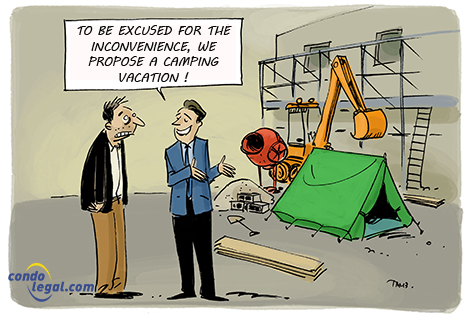 In principle, the work undertaken by the syndicate should not cause harm to a co-owner. If he suffers a prejudice beyond a mere temporary nuisance, he is then be entitled to an indemnity. Article 1067 of the Civil Code of Quebec states that a co-owner may be indemnified by the syndicate, if the work was carried out at the request of the latter. This article lists the grounds for indemnification, namely the permanent diminution in the value of his fraction, a grave disturbance to enjoyment, even if temporary, or through deterioration to the private portion.
In principle, the work undertaken by the syndicate should not cause harm to a co-owner. If he suffers a prejudice beyond a mere temporary nuisance, he is then be entitled to an indemnity. Article 1067 of the Civil Code of Quebec states that a co-owner may be indemnified by the syndicate, if the work was carried out at the request of the latter. This article lists the grounds for indemnification, namely the permanent diminution in the value of his fraction, a grave disturbance to enjoyment, even if temporary, or through deterioration to the private portion.
What is a permanent diminution in the value of the fraction?
A permanent diminution in the value of the fraction refers to a loss of economic value experienced by a co-owner's unit due to work done in or near their private portion. This can result from a permanent and irreparable issue caused by the work, which alters or even eliminates the specific qualities of a private portion. Even if physical damage is repaired, a loss of value may result from a permanent modification to the condition or appearance of the unit, making it less attractive or functional, or reducing its overall comfort.
Examples of a permanent diminution in the value of the fraction:
What is a grave disturbance to enjoyment?
A grave disturbance to enjoyment is defined as a substantial disruption that prevents the co-owner from fully enjoying their private portion. This may include any situation where the normal use or occupancy of the unit is significantly affected, even temporarily. The disturbance can result from physical, noise, smell, or any other form of discomfort caused by the work.
Some concrete examples of what could constitute a significant enjoyment disturbance:
Compensation for a co-owner is possible only if they suffer significant harm that goes beyond mere temporary inconvenience. The inconvenience must exceed the level of inconvenience that everyone is expected to tolerate due to work carried out in the co-ownership, such as the impossibility to live in his unit or to use his terrace during roof repairs.
Consequently, disturbances without significant severity, as well as normal and inevitable minor inconveniences caused by the work, are excluded. If the damage is minor and the work does not require the co-owner to leave their apartment or prevent them from carrying out their normal activities, the syndicate may be justified in not compensating them.
What is deterioration to the private portion?
Deterioration to the private portion refers to physical damage caused inside a co-owner's unit during the execution of work, whether carried out by the syndicate or another co-owner. This damage can affect various components of the unit, such as walls, floors, or sanitary installations.
Examples of damage to the private portion:
Damage assessment
It is up to the co-owner to evaluate the damage he has suffered. If the disturbance of enjoyment is only temporary, he will be entitled to a compensatory indemnity. However, if the damage is permanent, the syndicate may, in certain circumstances, have certain work carried out in a unit to remedy the damage suffered. This could be the case with soundproofing work on an apartment to protect it from noise pollution attributable to the operation of a new elevator. Therefore, the compensation must correspond to the cost of this work. However, if it is impossible to remedy the disturbances of enjoyment, the co-owner is entitled to claim compensation covering him for the damage he suffers. It is sometime helpful to retain the services of a knowledgeable expert. The latter can appraise, for example, the cost of restoring the area affected by the work or the loss of the market value of the private portion. If the co-owner cannot come to an amicable agreement with his syndicate, he may take legal proceeding to obtain an indemnity.
 WHAT YOU SHOULD KNOW ! The right to an indemnity is provided by law and is of public order. If the declaration of co-ownership states that the co-owner must suffer the access to his private portion without an indemnity, this provision is deemed null and void and may not be applied by the court.
WHAT YOU SHOULD KNOW ! The right to an indemnity is provided by law and is of public order. If the declaration of co-ownership states that the co-owner must suffer the access to his private portion without an indemnity, this provision is deemed null and void and may not be applied by the court.
 WHAT TO KEEP IN MIND : The indemnity to be paid to a co-owner (by a syndicate) is allocated between all co-owners in proportion to the relative value of their fraction.
WHAT TO KEEP IN MIND : The indemnity to be paid to a co-owner (by a syndicate) is allocated between all co-owners in proportion to the relative value of their fraction.
 WARNING ! The indemnification principle has limitations. If the amount claimed is the subject of a dispute, it will be for the courts to assess the gravity of the disturbance. A co-owner cannot take Justice in his own hands by refusing to pay his common expenses, to compensate the damages he claims to have suffered.
WARNING ! The indemnification principle has limitations. If the amount claimed is the subject of a dispute, it will be for the courts to assess the gravity of the disturbance. A co-owner cannot take Justice in his own hands by refusing to pay his common expenses, to compensate the damages he claims to have suffered.
Back to the mega-fact sheet: The work of the syndicate in a privative portion

